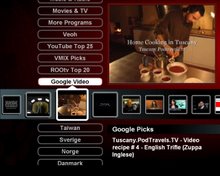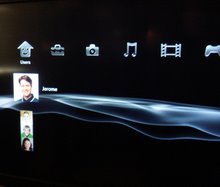Active-TV Ecosystem Developers,
The Issue: Enabling a living room TV to access video is the next big step in internet video distribution.
Solutions: Most proposed ‘solutions’ have followed a proprietary approach. The problem has defeated efforts from both large, well funded companies and inventive start-ups.
Behind the scene: Active-TV technology enables the success of PC-based video browsing to be re-applied to delivery of internet video to the living room TV.
The PC is the accepted platform for accessing internet video at home, but the video rarely reaches the living room since the PC is little used as a box attached to the TV. The lack of a common platform for internet-delivery of video to the TV has stalled progress overall and produced a long, drawn out race to solve the relevant technical and marketing problems. This race is driven by prospects of profit from offering TV viewers greater choice for video entertainment and supporting internet-delivery of TV advertising. The competition to find a solution has lasted several years now, perhaps more than ten, and progress seems so slow that it hardly seems worthy to be called a race.
Several years back, most observers felt the PC industry held the advantage: The PC had the performance, flexibility and software to tackle the problem, whereas system-on-chip (SoC)-based solutions used by TV and Set-Top Box (STB) manufacturers fell short. Years of development by TV SoC providers, however and repeated missteps by the PC industry have done much to level the playing field, but there is still no winner.
A modified PC platform using a Windows operating system is not likely to power the TV of the future. Only Apple is showing some success with this type of approach. But Apple TV uses a Mac OS and is a relatively expensive add-on box. The real race involves using the TV industry’s low-cost components while maintaining support for increasingly complex software to enable access to internet video. How can this be achieved?
Years of familiarity with the PC has led users to take for granted the PC’s ability to support complex operations under a polished user interface. The PC can easily be updated or applied to new tasks, whereas TV SoC solutions have far less flexibility. Over the years there have been many efforts to devise a solution; Including Intel VIIV clients, Microsoft’s Extenders, Akimbo’s STB and many lesser known projects. They have all failed to get the necessary software working reliably on low-cost platforms that are understood by users and therefore adopted in large numbers.
Yet the race goes on, with little reference to prior failures. Each new ‘solution’ is a dedicated single-task box, not a universal platform like the PC. There are 'good' reasons for this. Boxes are tied to a particular video service and the service provider is not interested in helping competition reach the TV. Each box includes software for the TV user interface (UI) and network communication. To add more options only adds to the cost and technical complexity of the box. No standard has emerged for universal stand-alone box operation, so the players each compete in the hopes of becoming the new de-facto standard. They stand little chance of ultimately succeeding.
Now, DivX is trying to enter the game and establish such a standard. A recent report on DivX Connected gives few details regarding the prototype GejBox. However, the report indicates: “so it's safe to say that while a select few beta testers will get to play around with a GejBox, this device will most likely never make it to market -- at least not in its current form. (DivX is really trying to get hardware-makers to pick up their platform; we don't think they want to be in the box business.)”
The Issue: Enabling a living room TV to access video is the next big step in internet video distribution.
Solutions: Most proposed ‘solutions’ have followed a proprietary approach. The problem has defeated efforts from both large, well funded companies and inventive start-ups.
Behind the scene: Active-TV technology enables the success of PC-based video browsing to be re-applied to delivery of internet video to the living room TV.
The PC is the accepted platform for accessing internet video at home, but the video rarely reaches the living room since the PC is little used as a box attached to the TV. The lack of a common platform for internet-delivery of video to the TV has stalled progress overall and produced a long, drawn out race to solve the relevant technical and marketing problems. This race is driven by prospects of profit from offering TV viewers greater choice for video entertainment and supporting internet-delivery of TV advertising. The competition to find a solution has lasted several years now, perhaps more than ten, and progress seems so slow that it hardly seems worthy to be called a race.
Several years back, most observers felt the PC industry held the advantage: The PC had the performance, flexibility and software to tackle the problem, whereas system-on-chip (SoC)-based solutions used by TV and Set-Top Box (STB) manufacturers fell short. Years of development by TV SoC providers, however and repeated missteps by the PC industry have done much to level the playing field, but there is still no winner.
A modified PC platform using a Windows operating system is not likely to power the TV of the future. Only Apple is showing some success with this type of approach. But Apple TV uses a Mac OS and is a relatively expensive add-on box. The real race involves using the TV industry’s low-cost components while maintaining support for increasingly complex software to enable access to internet video. How can this be achieved?
Years of familiarity with the PC has led users to take for granted the PC’s ability to support complex operations under a polished user interface. The PC can easily be updated or applied to new tasks, whereas TV SoC solutions have far less flexibility. Over the years there have been many efforts to devise a solution; Including Intel VIIV clients, Microsoft’s Extenders, Akimbo’s STB and many lesser known projects. They have all failed to get the necessary software working reliably on low-cost platforms that are understood by users and therefore adopted in large numbers.
Yet the race goes on, with little reference to prior failures. Each new ‘solution’ is a dedicated single-task box, not a universal platform like the PC. There are 'good' reasons for this. Boxes are tied to a particular video service and the service provider is not interested in helping competition reach the TV. Each box includes software for the TV user interface (UI) and network communication. To add more options only adds to the cost and technical complexity of the box. No standard has emerged for universal stand-alone box operation, so the players each compete in the hopes of becoming the new de-facto standard. They stand little chance of ultimately succeeding.
Now, DivX is trying to enter the game and establish such a standard. A recent report on DivX Connected gives few details regarding the prototype GejBox. However, the report indicates: “so it's safe to say that while a select few beta testers will get to play around with a GejBox, this device will most likely never make it to market -- at least not in its current form. (DivX is really trying to get hardware-makers to pick up their platform; we don't think they want to be in the box business.)”

The GejBox prototype, like the Apple TV, is a Digital Media Adapter (DMA) variant but likely built from lower-cost TV SoC technology rather than PC technology. In such a case it may have less stand-alone capability than Apple TV, relying more frequently on networked PC-assist for streamed content.
Like the Apple TV or the D-Link DSM-520, DivX Connected accesses photos, music and video stored on a networked PC. We can expect easy access to video encoded in the popular DivX codec. However, the D-Link DSM-520 also supports access to DivX encoded video. And Apple could easily enable support for the codec if it made marketing-sense to do so, and assuming the codec licensing fee was acceptable.
DivX Connected TVs access internet video from the DivX Stage6 and Google Video sites. Google video support is likely a vestige of prior agreements between DivX and Google. There is no mention of YouTube video which is primarily available in Adobe Flash Video (FLV) and increasingly available in H.264, and which possibly indicates some incompatibility between the use of these codecs and DivX Connected. There are also reports that other video sites will be added via DivX Connected plug-ins. This strategy would keep DivX in a controlling position regarding the look-and-feel and ‘suitability’ of an alternative video sharing site, a degree of control which consumers and video suppliers may not wish to accept.

The GejBox does not appear destined to enter the market. Instead, DivX plan to get hardware retailers to re-brand the box or port the DivX Connected technology into other boxes or TVs using similar SoC hardware. To accomplish this, DivX will have to drive demand for their Stage6 video sharing site. Without this demand, hardware retailers will show little interest. I think it unlikely Apple will add support for Stage6 via Apple TV. To achieve this demand, DivX co-founder Jordan Greenhall is moving to lead the Stage6 spin-off. From PaidContent.org: Stage6 is in tough competition and would require more investment and focus, something DivX can’t really afford . . . The success of Stage6 has been driving a significant increase in operating expenses, which has in turn impacted DivX operating income.”
Joost would also like to reach the living room TV. Mike Volpi, recently appointed CEO, stated in an interview when asked about his move to Joost: “Television is a massive market, and when you put it together with the Internet, and to be on the ground floor of that, there weren’t many other opportunities to do something this big.” A report claims, “a year from now we will see Joost in the living room”. This will require Joost embedding its version of the necessary support software into TVs and Set-Top Boxes. Likely the Joost software (generally know as firmware when embedded into a TV or STB) will make use of their own peer-to-peer networking protocols rather than the video streaming utilized by DivX Connected and Stage6. There are already set-top boxes in development making use of p2p technology from other bit-torrent software suppliers, but not surprisingly they are tied to other video portals, not Joost.
Unlike DivX, Joost has yet to reveal a prototype box. Joost has stated: “We would love to put Joost on the Apple TV platform”. But the lack of a universally accessible TV platform has resulted in winner-takes-all business models which rarely lead to such collaborations between ambitious players. In sum, both DivX and Joost have an uphill task to convince Set-Top Box and TV manufacturers to embed their particular firmware needed to access their respective internet video sites. This is why we see them promoting a DMA box solution, where the add-on box is tied to a particular video service. These boxes, however, compete with DMAs like the D-Link DSM-520, which have the advantage of using active-TV technology to enable universal access to TV-web.
Of particular interest among the DMA-styled approaches is BroadQ’s active-TV software for the Sony Playstation 2 (PS2). This enables existing PS2 users (over 100M) to access TV-web formatted video channels without being tied to any particular video portal. The PS2 continues to offer a price advantage over DMA alternatives for new adopters.
On the TV hardware side, it seems manufacturers all have projects to add computer networking support. Project teams have a lot of firmware options, but they don’t like the choices offered by video portal promoters. A typical TV shopper expects a TV to last between six and ten years, or more. It is hard to expect embedded video technology tied to a particular video sharing service to remain current for anything like this period. It is not unusual to see several updates per year for a video sharing site accessed via the PC. Moreover, the process of updating the TV firmware or ensuring prior TV purchasers can support new features is just too complex. Hence, why add to the cost and complexity of a TV, given so many unknowns and competing business models, when much of the uncertainty and challenge can be passed off to the PC? TV manufacturers would prefer to add a single firmware component that enables access to all internet video providers. This option exists for PC-assisted operation but not stand-alone TV operation. It is referred to as active-TV technology.
Video sharing sites all support access via the PC browser. In short, all video sharing and distribution sites can be accessed via a PC. Active-TV technology extends this by delivering TV-formatted video to any networked TV. The PC and its browser ‘engine’ remain the standard universal platform for formatting a TV UI. Future developments in technology and software are dealt flexibly by the PC, to ensure that the networked TV remains operational and up-to-date for many more years than could ever be achieved by a TV operating alone. Embedding complex software development into a TV SoC chip is essentially replaced by lower-cost and universal PC browser-based software development. There are a great many advantages to this approach. Consequently, active-TV technology has gained acceptance with TV manufacturers producing TVs sold in the retail market who need not bet on any particular video portal service but can support them all, whether YouTube, MySpace or others.
Ultimately, the networked TV is the ideal approach. But the cost increment must be very small, and the traditional TV characteristics of longevity, zero maintenance, universal channel access and reliability must be guaranteed. PC-assist via active-TV technology satisfies all of these requirements. The very open glasnost approach of active-TV means that the TV consumer is largely removed from divisive embedded firmware battles, such as with a Joost box not supporting access to DivX’s Stage6 or the Apple’s video portal; or with DivX Connected not supporting access to Joost video or the Apple’s video portal; or with Apple TV not supporting access to Stage6 or Joost. These exclusive business strategies have been failing for years, although they continue to be promoted.
In summary, given the history of miss-steps and technical and marketing complexities of brining internet video to the living room TV, Steve Jobs has wisely indicated that Apple TV is a long-term project. After some reflection a Joost spokes person has added: "Some recent articles have reported that Joost is moving into the home. While technically possible, the emphasis is all wrong. Joost does want to be in the living room, but it's going to take time. Right now we're focusing on creating the best software for the current platform - the personal computer”. Meanwhile, the ability of active-TV technology to re-apply the PC’s success with web-based video sharing makes it formidably competitive: it can deliver internet video to the TV without requiring that a PC be built into the TV.
Feedback, corrections and comments welcome. Contact me for more information or support with active-TV technology development.
Daniel Mann









5 comments:
Hi !.
You re, I guess , probably curious to know how one can collect a huge starting capital .
There is no initial capital needed You may begin to receive yields with as small sum of money as 20-100 dollars.
AimTrust is what you thought of all the time
AimTrust incorporates an offshore structure with advanced asset management technologies in production and delivery of pipes for oil and gas.
It is based in Panama with structures everywhere: In USA, Canada, Cyprus.
Do you want to become an affluent person?
That`s your chance That`s what you wish in the long run!
I feel good, I started to get income with the help of this company,
and I invite you to do the same. If it gets down to choose a proper partner utilizes your funds in a right way - that`s AimTrust!.
I take now up to 2G every day, and my first deposit was 1 grand only!
It`s easy to join , just click this link http://lewatigoc.lookseekpages.com/okafymij.html
and go! Let`s take this option together to get rid of nastiness of the life
Good day !.
might , perhaps curious to know how one can reach 2000 per day of income .
There is no initial capital needed You may commense earning with as small sum of money as 20-100 dollars.
AimTrust is what you thought of all the time
The firm incorporates an offshore structure with advanced asset management technologies in production and delivery of pipes for oil and gas.
It is based in Panama with structures around the world.
Do you want to become really rich in short time?
That`s your chance That`s what you desire!
I feel good, I started to get income with the help of this company,
and I invite you to do the same. If it gets down to select a correct partner who uses your money in a right way - that`s AimTrust!.
I take now up to 2G every day, and my first investment was 500 dollars only!
It`s easy to get involved , just click this link http://asujafex.kogaryu.com/pejaly.html
and go! Let`s take this option together to become rich
I love having an iphone because I am able of downloading videos from youtube and the sound is amazing. It is very nice because the screen is big.
Technology is very important, so it depends on the use we want to giving it, we should be careful because sometimes technology could be dangerous, even you don't believe it.m10m
Hi, listen, I'm pretty new on this blogosphere and Internet thing, so I don't know if there's a sort of "subscription" method that I can use in order to receive notifications of your new entries...? Thing is I enjoy reading your blog a lot and I'd like to be up to date with your posts!
Post a Comment